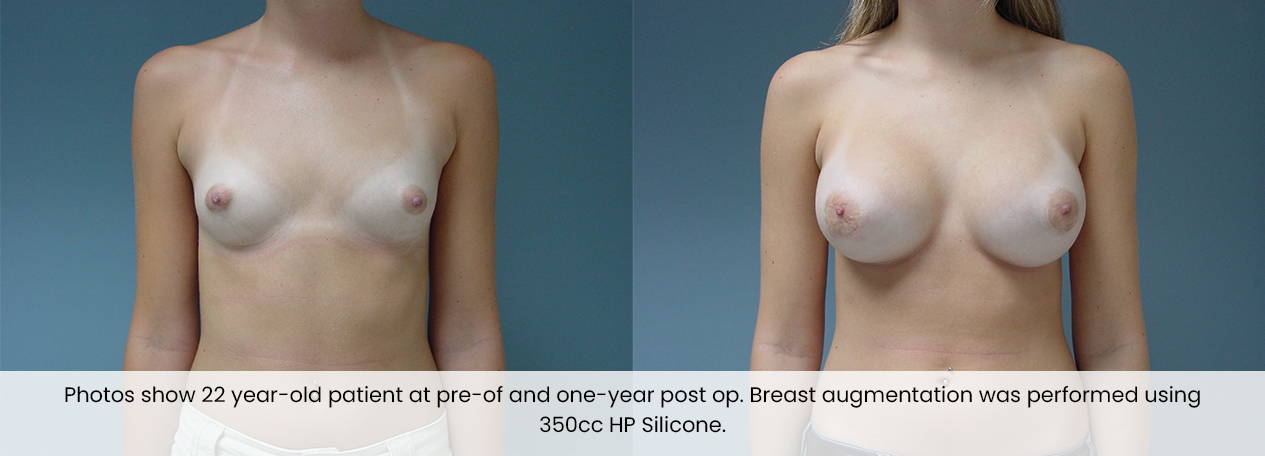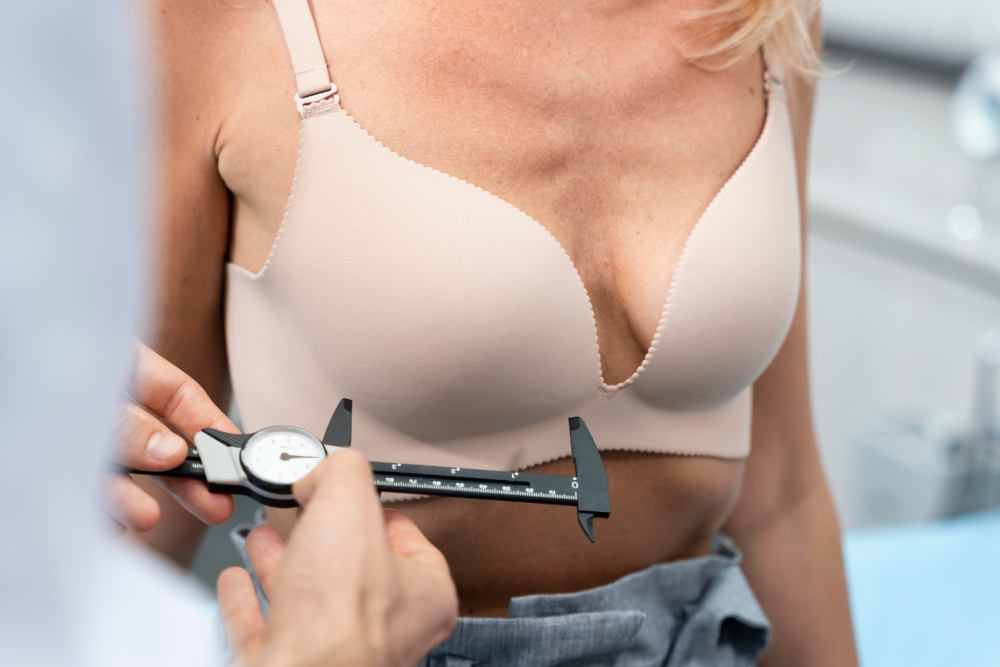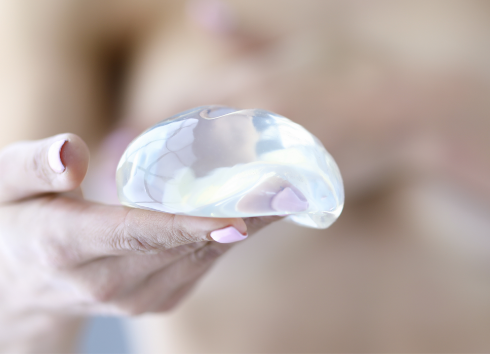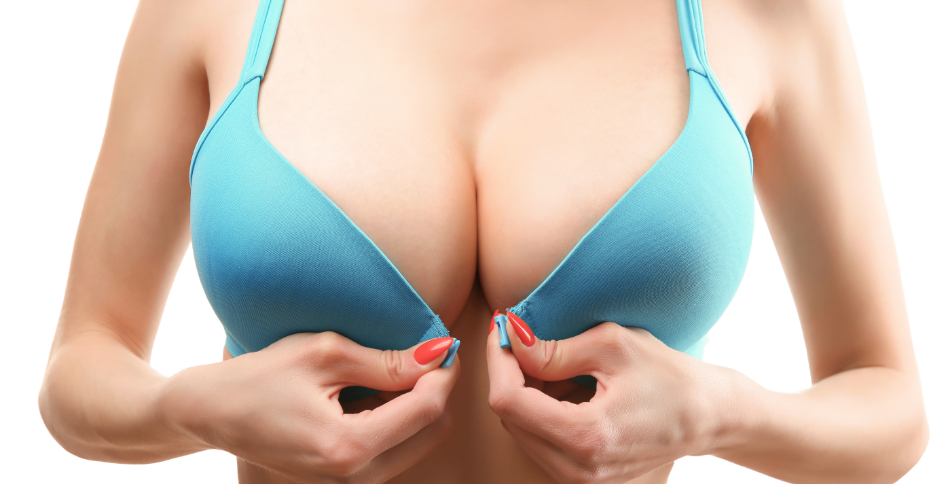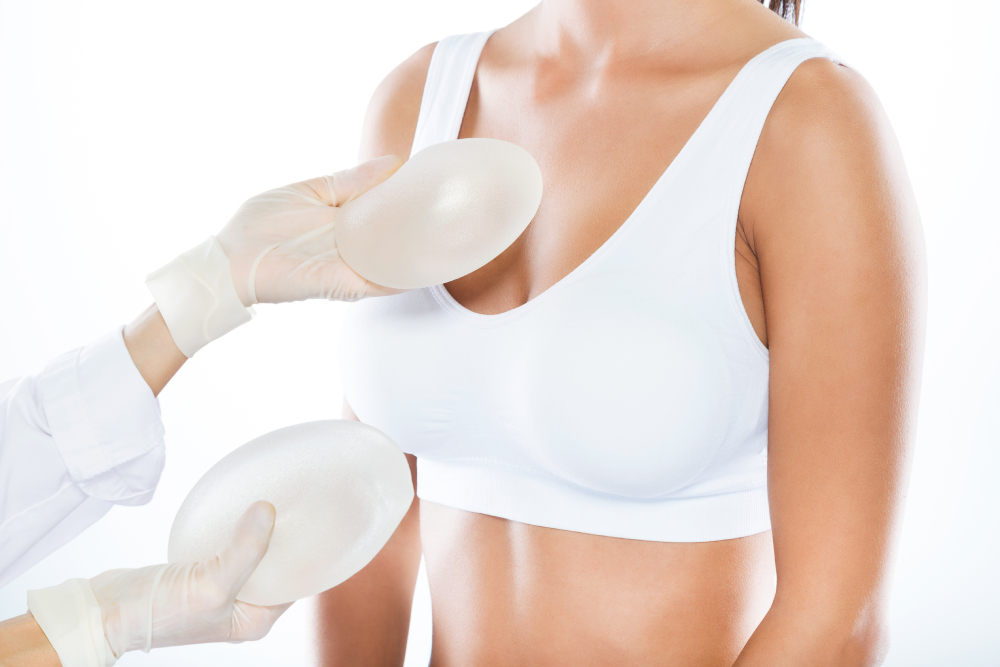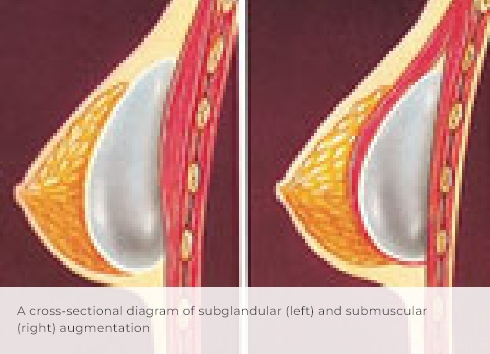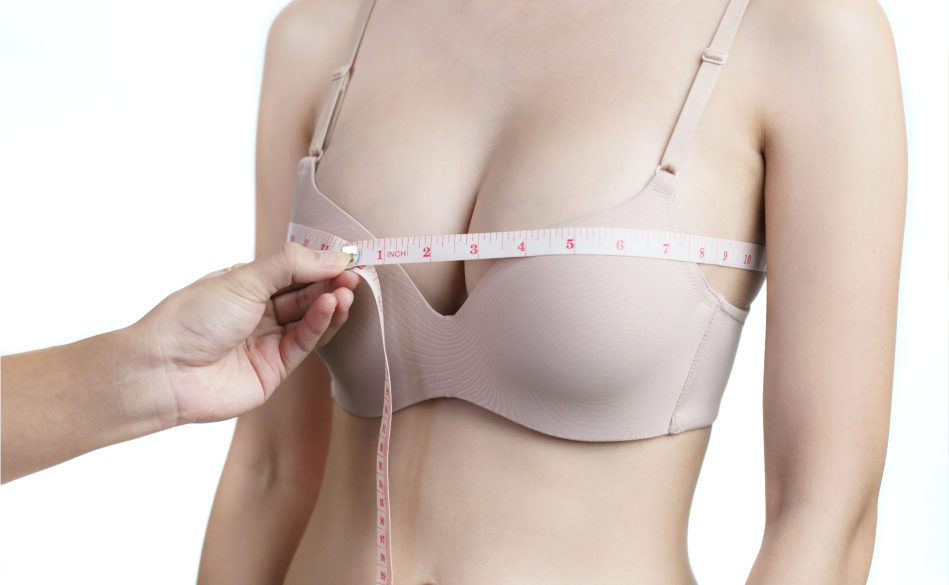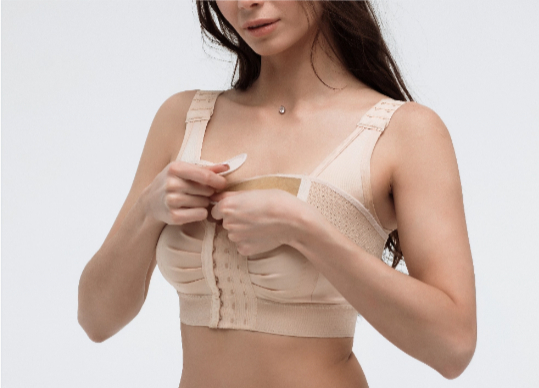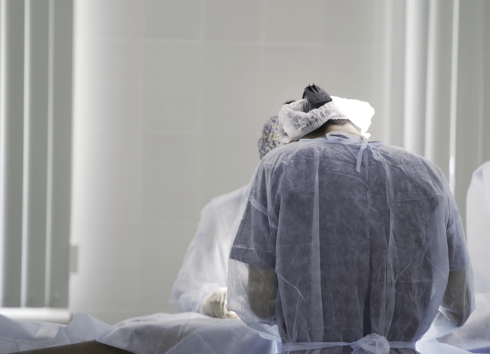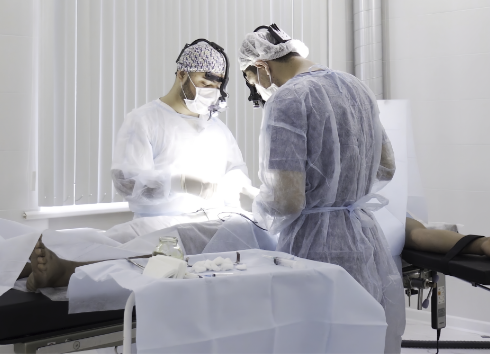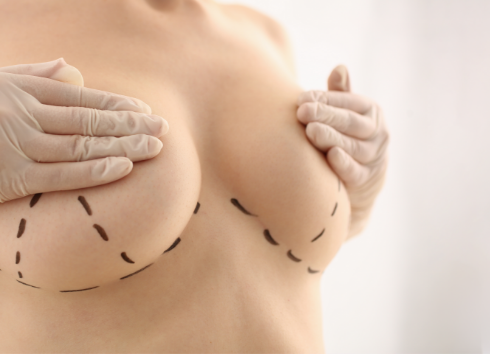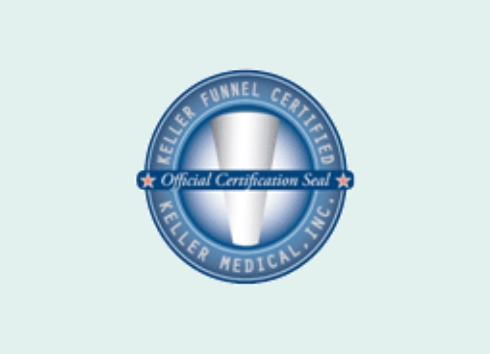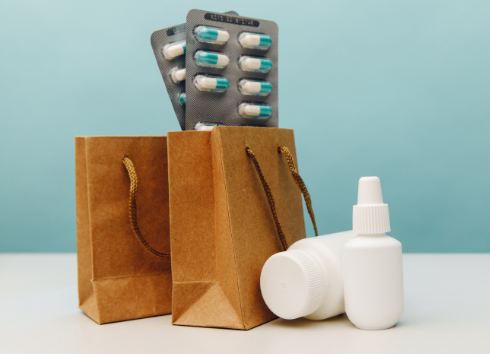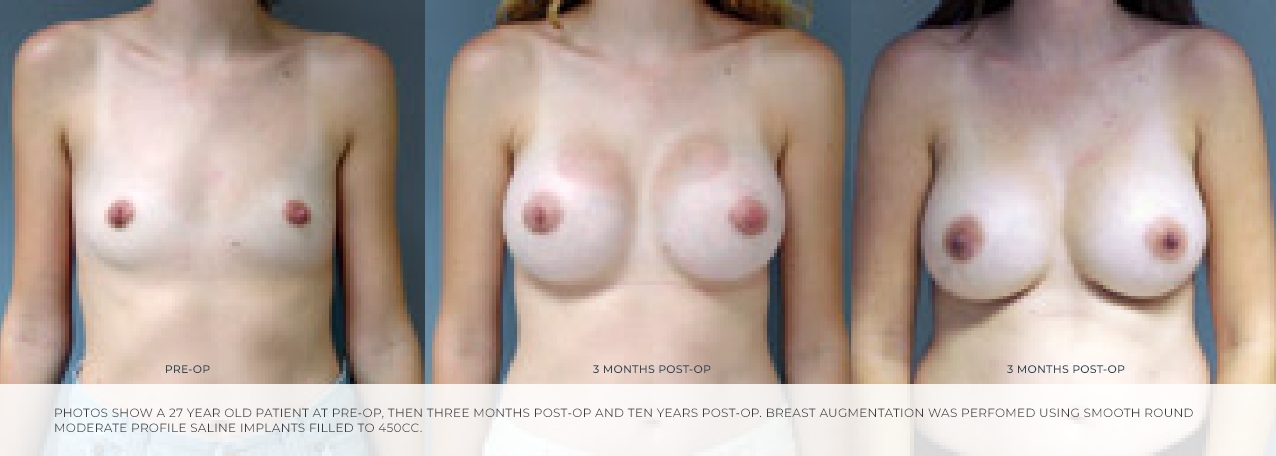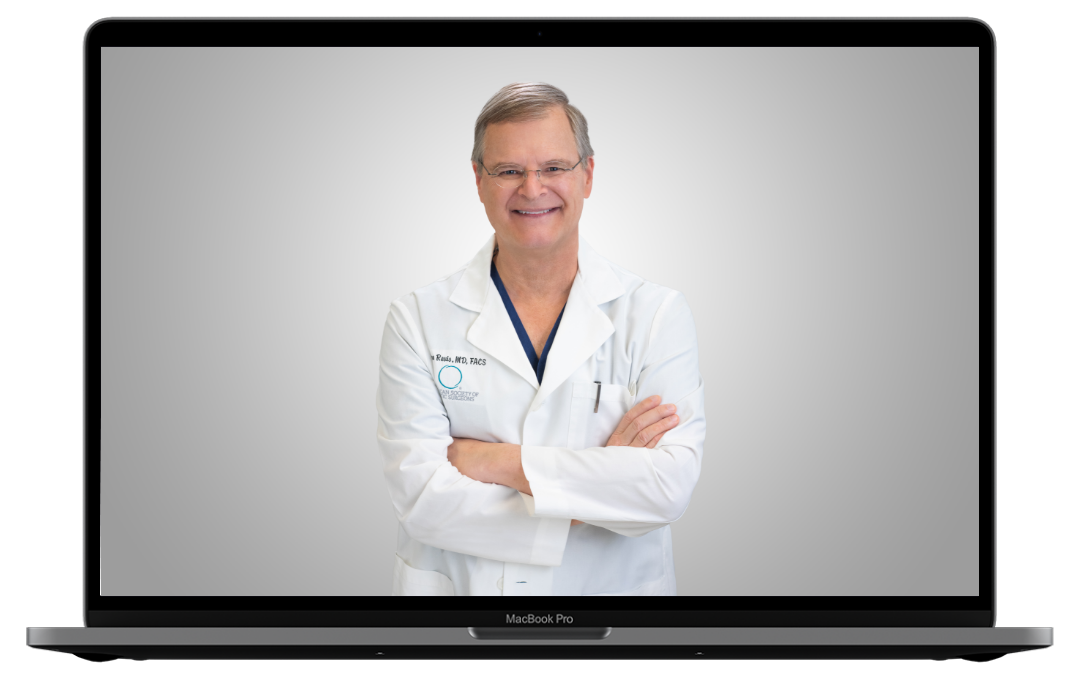-
- She may feel that her breasts are too small for her body
- She may feel that her upper body is out of proportion to her lower body
- She may have breasts that differ in size and/or shape
- She may wish to restore breast volume lost as a result of pregnancy, breast feeding or weight loss
Enhance the Size and Shape of Your Breasts
Although board certified in the entire spectrum of plastic surgery, Dr. Revis has chosen to focus his practice on breast augmentation surgery, which he practices exclusively. Within that spectrum, he has developed a special interest in breast augmentation and its potential problems. Breast augmentation surgery — both new and revisionary procedures — are the most common procedures performed by Dr. Revis (600-650 breast implant procedures each year). In the interest of your safety, he only performs surgery in a fully accredited ambulatory surgery center with M.D. anesthesiologists.
Dr. Revis has been selected as one of only 35 members for the Mentor Worldwide LEAD Council. Read more about Mentor’s LEAD Program Advisory Board.
What is Breast Augmentation and Why Get One?
Breast augmentation, also known as augmentation mammoplasty, is a surgical procedure to enhance the size and shape of a woman’s breasts. Approximately 400,000 women choose to undergo breast augmentation in the United States each year, making it the second most popular cosmetic procedure in the United States after liposuction. There are many reasons a woman may pursue breast augmentation:
Are You a Good Candidate for a Breast Augmentation?
If you think you might be a good candidate for breast augmentation, this page will give you a basic understanding of the procedure and the results you can expect. Because of Dr. Revis’ special interest in this procedure, he has developed a systematic approach to optimize your satisfaction and reduce the need for revisionary procedures following breast augmentation. This approach includes a thorough preoperative evaluation, accurate preoperative sizing, an emphasis on achieving a natural feel and appearance following breast augmentation, and the prevention of complications such as capsular contracture.
Individualize Treatment to Your Specific Circumstances
The cornerstone of Dr. Revis’ approach is to individualize treatment to your specific circumstances and goals and to ensure that you have an adequate understanding of the issues involved so that you are able to make a fully informed decision. This will help you achieve the appearance you desire with the least invasive procedure available, thus creating a mutually rewarding experience. Dr. Revis invites you to visit his office for a complimentary consultation to discuss the procedure in greater detail. You are also invited to email Dr. Revis with your questions, or we can mail you more detailed information regarding the procedure.
Our Pledge
As you consider plastic surgery, one of the most important decisions you will make is choosing your surgeon. Our pledge to you is to provide the latest, state of the art cosmetic plastic surgery in a safe and professional environment. Dr. Revis is a recognized specialist in the field of cosmetic plastic surgery and is board certified by the American Board of Plastic Surgery, the only plastic surgery board recognized by the American Board of Medical Specialties. He is also an active member of the American Society of Plastic Surgeons and The American Society for Aesthetic Plastic Surgery and has been named among “America’s Top Surgeons” by The Consumers’ Research Council of America.
Our goal is to provide you with the ultimate patient experience. Our well-trained staff will help you understand your procedure, our financial policies, the scheduling of your surgery, and your post-operative care. We are available to assist you during our regular office hours, Monday through Friday. Dr. Revis is also available 24 hours a day to post-surgical patients; he will give you his cell phone number after surgery so that you will always be able to reach him with any questions or concerns you might have during your recovery.
-
The Consultation
Enhance the Size and Shape of Your Breasts
Although board certified in the entire spectrum of plastic surgery, Dr. Revis has chosen to focus his practice on cosmetic plastic surgery, which he practices exclusively. Within that spectrum, he has developed a special interest in breast augmentation and its potential problems. Breast augmentation surgery — both new and revisionary procedures — is the only provedure performed by Dr. Revis (600-650 breast implant procedures each year). In the interest of your safety, he only performs surgery in a fully accredited ambulatory surgery center with M.D. anesthesiologists.
Dr. Revis has been selected as one of only 35 members for the Mentor Worldwide LEAD Council. Read more about Mentor’s LEAD Program Advisory Board.
Dr. Revis will be able to Offer Advice and Options
After reviewing your medical history, Dr. Revis will discuss your concerns, priorities and motivations for pursuing plastic surgery, as well as your fears. After examining you, Dr. Revis will be able to offer advice and options to help you achieve the appearance you desire. He will explain the advantages and disadvantages of the different options you have before you. You will also be shown the different types of breast implants, and you will have the opportunity to try on breast implant sizers with a soft surgical bra during your preoperative appointment. This will enable you to visualize how you will appear following your surgery and will assist you in selecting the proper size implant to meet your expectations.
The Final Decision Should be Given Very Careful Consideration
At the completion of your consultation, you will be given a written estimate of the cost of your procedure. At this time, you will also have the option to schedule your procedure if you so choose. The decision to undergo surgery is a very important one, and the final decision should be given very careful consideration. Dr. Revis realizes the importance of this decision, and at no time will you be pressured to make a decision. You are also encouraged to bring your spouse, significant other, family member, or a friend to your consultation.
Three Main Choices You Must Make
Breast implants come in many different types, and they may be placed through different incisions and in different locations. Once you have decided to undergo augmentation, there are three main choices you must make — incision location, implant type and size, and whether or not the implants will be placed above or below the muscle of the chest wall. This can be quite confusing, and the following information is to help you understand the various issues involved in making your decision.
-
Types of Breast Implants
Silicone Gel vs. Saline Filled Implants Breast Implants
There are two basic types of implants, silicone gel and saline filled. The new silicone gel implants arrive from the manufacturer already filled with cohesive silicone gel (not liquid silicone) in their sterile packaging. Saline implants arrive from the manufacturer empty, in sterile packaging, and are actually filled with sterile saline solution in the operating room. Saline implants typically lift better, and are more perky and rounded, whereas silicone implants are the most natural look and feel that you can achieve.
FDA Approved
After 15 years of intensive research, the new silicone gel implants were approved by the FDA in November 2006 and continue to be studied. To date, there have been numerous studies involving over one million women with the new silicone gel implants, and these studies clearly show no link between silicone gel implants and any type of disease.
During the 1992-2005 FDA study period of silicone gel implants, there were strict limitations on which women qualified to enter the FDA study protocol. Because of these limitations, the majority of women undergoing breast implant surgery chose saline implants. Now that the restrictions have been lifted and silicone gel implants are available to everyone, the numbers are much more equal in terms of what type of implant a woman chooses.
Saline Implants have an Advantage in Some Patients
Silicone gel implants have an advantage in some patients because of their softer, more natural feel. In fact, many women who have saline or the older type of silicone implants are now having them replaced with the new cohesive silicone gel implants (also called gummy bears). Saline implants have an advantage in some patients because they may be adjusted in the operating room if your breasts are different sizes (thus achieving better symmetry), they lift better (in patients who have any sagging), provide more roundess and cleavage (for patients who want a more augmented look), can be filled above 800cc (silicone only goes up to 800cc), and if rippling is a concern (overfilled saline implants ripple less than silicone).
Which Implant Type Might be the Best
There are several reasons a woman might choose one type of implant over another, and these include body type, current breast size, and the desired look and feel after surgery. During your consultation, Dr. Revis will discuss with you which implant type might be the best choice for your individual needs. You are encouraged to bring any wish pics or goal pics you may hev found to your consultation or preop appointment.
Breast Implants are Available in Three Different Profiles
Both saline and silicone round breast implants are available in three different profiles — Moderate, Moderate Plus and High. Silicone implants also come in UltraHigh, Xtra and BOOST profiles. The difference between these types is the diameter and projection. The traditional, or original, profile available was the Moderate. For any given size in cc, the Moderate profile implant will have the widest diameter and the least projection (they will be the flattest and widest). The UltraHigh profile implant is the narrowest in diameter with the greatest projection. Moderate Plus, High Profile, Xtra and BOOST implants fall in between. We will discuss which implant type and style would best fit your needs during your consultation based on the measurements Dr. Revis takes of your chest, the review of pre- and postop photographs, and when you try on the implant sizers.
See detailed information about Allergan breast implants and Mentor breast implants
-
-
Implant Placement
Subglandular vs. Partially Submuscular vs. Totally Submuscular Implant Placement
Breast implants may be placed beneath the tissue of the breast (subglandular), or may be placed even deeper, beneath the muscle of the chest wall (totally submuscular). There is also a subpectoral (or partially submuscular) placement that some surgeons use, meaning that the implant is placed beneath the pectoralis major muscle only, leaving the outer, lower 1/3 of the implant not covered by muscle tissue. The decision is a very individual one, and it is determined by the natural shape of your breasts and chest wall muscles.
Dr. Revis Prefers Submuscular Position
Whenever possible, Dr. Revis prefers to place the implants in a totally submuscular position. Dr. Revis believes that the advantages of placing the implants completely beneath the muscle of the chest wall greatly improve the long-term appearance of your breasts following augmentation. This is for three main reasons. First, mammography is easier and the quality is better when the breast implant is separated from the breast tissue by the layer of muscle. Secondly, there is a 50% reduction in the incidence of capsular contracture when the implants are placed totally beneath the muscle. Capsular contracture occurs when the body produces scar tissue around the implant. This may change the shape of the implant and make the breasts asymmetric and painful. Finally, placing the implants beneath the muscle of the chest wall makes your breasts appear more natural because there is more of your own tissue covering the implant, making it less likely that you will be able to see (visibility) or feel (palpability) the implant.
Dr. Revis uses a special technique and instruments to place the implants 100% beneath the muscle of the chest wall without cutting any of the muscle tissue. This entirely submuscular placement will improve your long-term results and minimize your potential complications. It also yields little or no bruising post-operatively.
-
Choosing the Proper Implant Size
We Help you Make The Best Decision Based on your Anatomy
This is one of the most important decisions you will make. Because of this, we use several approaches to help you make the best decision based on your anatomy, personal preferences, and the appearance you wish to achieve. Interestingly, in a recent national survey, over 80% of patients undergoing breast augmentation stated that a C cup was their desired post-operative goal. A D cup was the second most popular request.
How We begin
We begin by showing you numerous examples of patients who have had augmentation. By finding someone who has a similar preoperative appearance and evaluating their results with the size they chose, you can get an idea of whether or not you like the size they chose or if you would like to be smaller or larger than their final appearance. You may also wish to bring goal pics or wish pics you may have found to better communicate with Dr. Revis regarding the exact size, shape and look you are trying to achieve.
Starting Point for Discussion
Dr. Revis will also measure your natural breast and chest shape. This gives him an idea of what size implant will help you achieve the size you want post-operatively. As implant size increases, so does the diameter of the implant. There is an implant that will perfectly match the diameter of your natural breast, and that is a good starting point for discussion. Choosing an implant smaller than your natural breast shape will not provide the proper cleavage and shape following the procedure, and most commonly results in a large gap between the breasts. Similarly, choosing an implant too large for your natural chest shape is more likely to give you an unnatural appearance.
Implants do not Come in Cup Sizes
Unfortunately, implants do not come in cup sizes. Rather, they are categorized by the volume of filler (saline or silicone gel) they are designed to hold. There are several reasons for this. First, your final cup size will be partially determined by your preoperative breast size, and everyone is different in this regard. Secondly, a C cup from one bra manufacturer is not necessarily the same as a C cup from another manufacturer. Although everyone is built differently and bras are not manufactured to a set standard, you can expect that a cup size is approximately 200cc in a person of average height and average build. If you are tall or have broad shoulders, you can expect that number to be slightly higher. Similarly, if you are shorter or have a more narrow chest, you can expect that number to be slightly lower. Although a desire for a certain cup size is helpful to Dr. Revis in guiding you in the selection of the proper implants, it is more helpful to focus on the shape and appearance that you wish to achieve.
Trying on of Breast Implant Sizers
Finally, we will have you try on various implant sizers in a surgical bra. You may wish to bring a bathing suit, tank top or other clothing to see how you will look with different implant sizes. This helps confirm that you are making the right implant choice. We usually perform the trying on of breast implant sizers during the preoperative visit. This is because the initial consultation is very thorough, lasts approximately one hour, and tends to provide you with a tremendous amount of information to digest. In his experience, trying on implants at this point in the developing physician-patient relationship rarely leads to a conclusive decision and almost always needs to be repeated. However, we also understand that many patients travel a long distance for a consultation with Dr. Revis. With that in mind, we are willing to be as flexible as possible with out of town patients and allow the trying on of implant sizers during the initial consultation if we are given enough advance notice to schedule a more lengthy appointment. Also, please feel free to make as many trips to the office as you need to be satisfied with your implant selection. Our goal and the measure of our success is your happiness.
-
Where Your Procedure Will Be Performed
Breast Augmentation
Experienced in The Care of Plastic Surgery Patients
Dr. Revis has been granted staff privileges at our local hospitals and outpatient surgery centers. In the interest of the safety of his patients, he only performs surgery in fully accredited facilities with the proper services and staff. Dr. Revis usually performs breast augmentation at Physicians Outpatient Surgery Center (POSC) at the Holy Cross HealthPlex or Imperial Point Surgery Center, both fully accredited ambulatory surgery centers run by a hospital. The staff of these facilities are very experienced in the care of plastic surgery patients in general and specifically in the care of Dr. Revis’ patients.
-
Types of Anesthesia
Essential Anesthesia is Safety
Anesthesia is an essential part of any surgical procedure and must be performed safely. Endotracheal intubation is the deepest form of anesthesia. You have an endotracheal tube inserted into your trachea, you are given muscle paralytic agents, and the ventilator is doing your breathing for you during surgery. This form of anesthesia is usually not required for breast augmentation unless the patient specifically requests intubation or the patient has a difficult airway as assessed by our board certified M.D. anesthesiologist.
Intravenous sedation, called twilight sleep
Intravenous sedation, called twilight sleep, is a combination of local anesthetic administered at the surgical site by Dr. Revis and intravenous sedation administered by the anesthesiologist. You breathe for yourself, but you are in a deep sleep throughout the procedure. You should feel no pain, and you will not remember the procedure.
New Technique: The Laryngeal Mask Airway
An intermediate form of anesthesia, the laryngeal mask airway (LMA), is a relatively new technique. This technique is similar to twilight sleep in that you are breathing on your own, but the method of sedation differs. With an LMA, you actually breathe anesthetic gases administered by the anesthesiologist, rather than receive intravenous sedation via your intravenous line. These anesthetic gases cause you to sleep during the procedure. At the completion of the procedure, the gases are turned off and you wake up from your sleep. You will feel no pain, and you will not remember the procedure. This is the most common type of anesthesia used by Dr. Revis because he feels that the effects of this type of anesthesia leave your body the fastest, allowing you to feel better faster with very little likelihood of post-operative nausea.
technique that has resulted in a very low incidence of post-operative nausea and vomiting.
The prevention of post-operative nausea and vomiting is also a focus of Dr. Revis’ approach to breast augmentation. To improve your overall experience and ensure you feel better faster following your augmentation, he has developed a technique that has resulted in a very low incidence of post-operative nausea and vomiting. You may be given Zofran and/or Emend, the best medications available to prevent nausea and vomiting. Dr. Revis feels it is a very important component of his overall approach to make sure that your experience is as pleasant as possible.
Dr. Revis will discuss all of these options with you more thoroughly at the time of your consultation, and please ask him about anything you do not understand.
-
Details of the Procedure
How Long is The Procedure?
Breast augmentation usually takes one to one and a half hours to perform. After you have changed into a gown and had your intravenous line started, you will be given a dose of intravenous antibiotics as a precautionary measure. Dr. Revis will use a surgical marking pen to identify certain landmarks on your chest. This ensures proper implant placement and symmetry post-operatively. He will also review the entire operative plan with you including incision location and implant type and size.
Accomplishing Several Objectives.
After you are properly anesthetized in the operating room, Dr. Revis will inject a solution of local anesthetics along the borders of your breasts, underneath the intended incision site, and into the muscle under which the implants will be placed. This injection solution consists of a special combination of lidocaine (xylocaine), marcaine (sensorcaine, bupivicaine) and epinephrine. This accomplishes several objectives. First, the epinephrine causes vasoconstriction of the area, reducing your potential for bleeding and bruising. Secondly, the lidocaine provides a rapid numbing of the area. Although you are asleep, this prevents the brain from registering any pain from the region during the operation. Studies have shown that this preemptive analgesia actually decreases your sensation of pain post-operatively, decreases the amount and length of time you will need to take pain medication post-operatively, and also leads to a more rapid return to normal daily activities. Finally, the marcaine component of this local anesthetic mixture is a long-acting local anesthetic. This actually prolongs the numbness of the area, making you more comfortable following surgery and delaying the time at which you will begin to need any pain medications.
Insertion and Filling of Saline Implants
Once the pockets have been created, the breast implants are inserted and filled with saline. Dr. Revis uses a no touch technique when placing the implants into the pocket. This includes using new sterile towels to drape around the breasts, changing his gloves and washing the outer surface of these new gloves in sterile saline, and only opening the sterile implant packaging immediately prior to insertion. Dr. Revis is the only person who ever touches the implants, and his goal is to minimize the time the implant is exposed to the air in the operating room prior to insertion into the pocket. Additionally, Dr. Revis does not allow the implant to come into contact with any instruments or the skin during the insertion process. He feels that this minimizes the possibility of any foreign material coming into contact with the implant and causing any inflammation.
Dr. Revis uses a closed system
During the filling process for saline implants, Dr. Revis uses a closed system to fill the implants with saline. This means that the saline that enters the implant is never at any time exposed to the air in the operating room. The saline flows from a sterile bag through a sterile tubing directly into the implant. Dr. Revis feels this additional precaution prevents any foreign material from inadvertently being injected inside the implant.
Insertion of Silicone Breast Implants
Dr. Revis will use the innovative Keller Funnel to place the silicone breast implants into the new pockets. The Keller Funnel employs the no-touch technique, reduces trauma to both the implant and patient tissues, and allows the use of smaller incisions. Read more about the Keller Funnel.
Dr. Revis will use the innovative Keller Funnel to place the silicone breast implants into the new pockets. The Keller Funnel employs the no-touch technique, reduces trauma to both the implant and patient tissues, and allows the use of smaller incisions. Read more about the Keller Funnel.
Suturing and Dressing
After the implants have been placed (and filled properly, in the case of saline implants) and Dr. Revis has assessed your final shape and size, the incisions are carefully closed with absorbable sutures to minimize your scar. A sterile dressing is applied to the incisions, and a soft surgical bra is placed over your breasts. Dr. Revis uses a technique in which all of the sutures are placed beneath the skin and are absorbed by your body. Not having to undergo suture removal has improved patient comfort and satisfaction.
-
Products to Help You Heal
Silagen or Skinuva– Made with 100% pure medical grade silicone, these products offer a clear, fast drying gel that will help flatten, soften and smooth scars. It also helps reduce redness, discoloration, itching, and pain.
Arnica Montana/Bromelain Complex is a natural product from Sweden which has been shown in clinical studies to reduce post-operative bruising and swelling. Begun the evening prior to surgery, this product is continued for four days post-operatively.
Available for Purchase
These products are available for purchase in our office. Please ask us about these products and others if you have any further questions about whether or not these would be beneficial for you during your healing period.
-
After Your Procedure
After Recovering
Breast augmentation is performed as an outpatient procedure. After recovering in the recovery room for approximately one hour, you will be able to go home in the company of a friend or family member. Dr. Revis will also give you his cell phone number so that you may reach him directly at any time with any questions you might have.
You will be in The Recovery Room
When you wake up from your procedure, you will be in the recovery room and will be wearing a soft surgical bra or sports bra. You may remove this bra on the second day following surgery and begin showering daily. After showering, simply pat your incisions dry and replace your surgical bra or similar fitting bra. Depending on whether yours is a first time augmentation or a revision, Dr. Revis will direct you in his preferred protocol for bra wearing during the initial postop period.
Continue this Medication for Five Days
The antibiotics that were prescribed during your preoperative visit (usually Augmentin) should be taken twice daily beginning on the evening prior to surgery. Continue this medication for five days post-operatively or until it is gone. The pain medication prescribed by Dr. Revis during your preoperative visit should be taken fairly regularly, every four hours or so, during the first 24 hours (when you are not asleep, of course). Most patients find that they are able to transition to Tylenol or Ibuprofen after three or four days. It is not safe to drive a car within 24 hours of taking pain medication, as your reflexes and alertness may be altered. Dr. Revis may prescribe a muscle relaxant (usually Flexeril) for you if he suspects that your muscles may be tight and uncomfortable following surgery. If so, you may take one tablet every eight hours if needed for muscle tightness.
No strenuous activities
You should plan to take it easy following your surgery. No strenuous activities, heavy lifting (over 20 pounds), aerobic exercises, swimming, contact sports, tennis, or golf should be planned for the first three weeks. As Dr. Revis monitors your recovery, he will advise you when it is safe to resume specific activities.
Unlike many surgeons, Dr. Revis does not feel that you must follow any specific regimen of straps, massaging, etc., following your augmentation. His philosophy is that the time to place the implants properly and precisely is in the operating room through careful technique and attention to detail. In his opinion, there is very little manipulation that straps or massaging will accomplish in the post-operative period to change the position or shape of an improperly or hastily placed implant. Dr. Revis will, however, occasionally recommend gentle massaging as a way to relax the muscle under which the implant is placed. In select patients, this can lead to a more rapid relaxation of the muscle and a softening of the breasts. Dr. Revis will instruct you during your post-operative visits in the proper technique of massaging the implants if he feels this would be of benefit to you.
Proper Massage Technique
The following patient video demonstrates the proper massage technique:
Dr. Revis will also discuss the use of a scar-healing product with you following surgery. Beginning three weeks post-operatively, daily or twice daily use of this product will stimulate rapid wound maturation and fading of your scar to a barely noticeable thin line.
-
- Precise breast and chest measurements
- Accurate preoperative sizing using implant sizers and photos
- Careful preoperative marking
- Efficient use of the operating room to reduce operative timeNo intubation
- No intubation
- No paralysis
- No ventilator
- Combination anesthetic involving IV, gas and local anesthetics
- Careful, precise dissection of the pocket with minimal tissue trauma
- Minimal bleeding
- No touch technique for implant insertion
- Keller funnel for silicone implant insertion
- Avoidance of cutting the pectoralis muscle
- Avoidance of blunt dissection
- Prevention of nausea
Rapid Recovery Breast Augmentation
Also called Flash, Quick, or One Day Recovery
In your research leading up to your selection of a plastic surgeon, you may have heard of Rapid Recovery, also called Flash, Quick, or One Day Recovery. These are often used merely as marketing terms to mislead a potential patient into thinking a particular surgeon has invented some type of revolutionary approach for breast augmentation.
Systematic Approach
It is common sense plastic surgery to place patient safety, comfort and satisfaction above all else. In Dr. Revis’ opinion, the principles of a systematic approach to breast augmentation should be considered standard in the industry for every board certified plastic surgeon.
In Dr. Revis’ practice, this systematic approach includes the following:
Preoperatively:
Intraoperatively:
-
The Results You Can Expect
Get ready!
You will notice an improvement in your breast shape and size immediately. You may experience tightness in your chest, but this rapidly resolves as the muscles relax. A very mild swelling usually takes several weeks to subside. You should be able to resume your normal daily activities the day after surgery, and you should be able to resume all of your physical activities (sports, aerobics, running, etc.) within three weeks of surgery. Please see our Preoperative Instructions and Postoperative Instructions for additional information.
A Better Approach
Because Dr. Revis places the implants 100% behind the muscle (totally submuscular) without cutting any of the muscle, your implants initially will appear too high. This is to be expected because the muscle will take a variable amount of time to relax. As your muscle relaxes, your implants will drop or settle into their intended position.
Total submuscular placement provides excellent long term support for your implants, helping maintain your results over time. The patient photos shown below illustrate the long-term results of submuscular implant placement. See long-term surgical results by Dr. Revis for patients two years or more post-op.
Call 954-630-2009 to schedule your consultation
Breast Augmentation Before & After Photos
View Photo Gallery
free Virtual Consultation
Get a FREE, no obligation consultation via email! Simply send in your photos to consult@drrevis.com and we will get back to you quickly!




